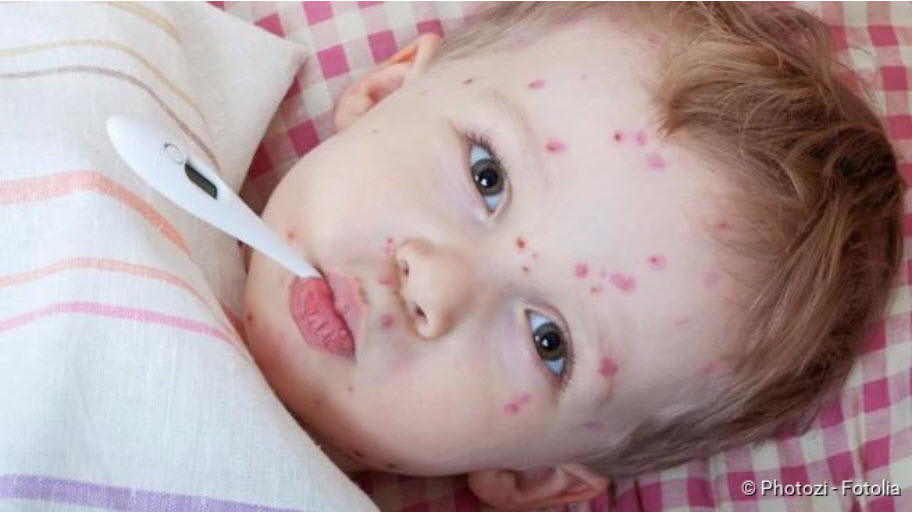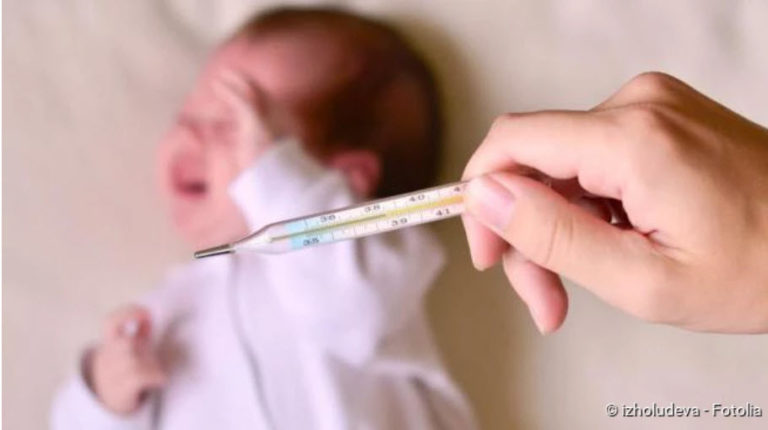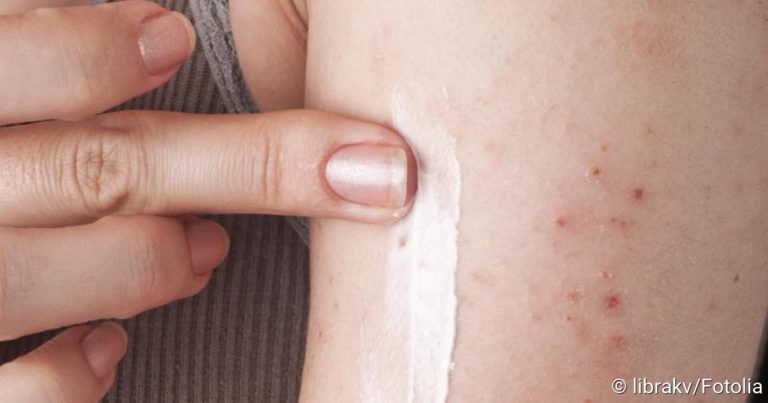Chickenpox: Infection, protection, symptoms
Chickenpox: Infection, protection, symptoms
Chickenpox (varicella) is a highly contagious viral disease transmitted by droplet or smear infection. The most noticeable symptom is an itchy rash with blisters. Mostly children and adolescents are affected by chickenpox, but adults can also be affected. Chickenpox usually runs its course without complications. However, pregnancy and a weakened immune system can complicate the course of the disease. Read more about infection and symptoms of chickenpox, duration of the disease, treatment and prevention.

Brief overview
- What is chickenpox? An infectious disease caused by the highly contagious Varicella Zoster virus (belongs to the herpes viruses). Chickenpox is one of the teething troubles, but can occur at any age – but only once in a lifetime. After an infection you are immune to chickenpox for life.
- Infection: Often through inhalation of small, virus-containing saliva droplets which the ill person releases into the air when coughing, sneezing or breathing out (droplet infection). Sometimes also by contact with the virus-containing liquid in the skin blisters of the diseased (smear infection).
- Symptoms: Initially general complaints such as malaise, headaches and aching limbs, fatigue and occasionally fever. Then the typical skin rash with fluid-filled, itchy blisters appears (first on the trunk and face, later also on other parts of the body).
- Treatment: mainly treatment of the symptoms (e.g. skin care, anti-itching medication, painkillers). In severe cases and at increased risk of complications, additional virus-inhibiting drugs (antivirals).
- Prognosis: Chickenpox usually heals without problems. Rarely do complications develop such as an additional bacterial infection of the skin, pneumonia, encephalitis or meningitis. Especially in adults, varicella often progress more severely than in children.
- Second disease: After a chickenpox illness, the pathogens remain in the body. They can later become active again and cause shingles (zoster).
- Prevention: Mainly by means of chickenpox vaccination. Those who are not vaccinated should avoid contact with sick people.
Chickenpox: Infection
Varicella zoster viruses are responsible for chickenpox infection. These are highly infectious herpes viruses that are found exclusively in humans. The risk of chickenpox infection is particularly high in the winter and spring months. During this time, therefore, the number of varicella infections increases.
The pathogens are usually transmitted by droplet or smear infection:
- In a droplet infection, tiny, virus-containing droplets of saliva from infected persons enter the ambient air by breathing out, speaking, sneezing or coughing and are then inhaled by healthy people.
- The smear infection is caused by direct contact with the virus-containing fluid from the patients’ characteristic skin blisters – for example, when the patient is touched by hand and then unconsciously grabs the mouth or nose. Once the viruses reach mucous membranes, they can easily penetrate the inside of the body.
There is already a risk of infection one or two days before the typical rash becomes visible! It only ends when all the bubbles are encrusted. This is usually the case five to seven days after the first bubbles appear.
Very rarely, varicella is transmitted from a pregnant woman to the unborn child via the placenta. Such a chickenpox infection in the womb can lead to the so-called fetal varicella syndrome. Chickenpox infection in newborns is also possible if the mother herself is infected with varicella shortly before or after birth.
Shingles patients are also a source of infection: Shingles is the second disease that varicella viruses can cause – even years after the chickenpox infection. Patients can pass on the pathogens to healthy people from the appearance of the rash until the vesicles are completely encrusted (usually five to seven days after the beginning of the rash). If they have not been vaccinated against varicella and have not yet had chickenpox, they can fall ill – with chickenpox, not shingles. However, shingles patients are less contagious than chickenpox patients.
Chickenpox: Incubation period
Chickenpox can appear 8 to 28 days after infection with the first symptoms. On average, this incubation period is 14 to 16 days. However, the disease only breaks out if you have never had chickenpox and have not been vaccinated against it. After a surviving infection one is immune to the chickenpox virus for life.
The majority of all cases of chickenpox are airborne. So you can’t protect yourself. Only a vaccination helps, if not 100 percent, of course. Chickenpox is also not a “harmless childhood disease”. Especially in children, unsightly scars are often left behind by scratching or a super infection with bacteria occurs. And I don’t wish any adult to get chickenpox!
Complications are relatively rare, thank God. The most common of these are bacterial superinfections, usually caused by staphylococci, cerebellar coordination disorders (ataxia) or the so-called sepsis, i.e. a bacterial infection affecting the whole body. In the worst case, however, chickenpox can be fatal without vaccination, according to a Swiss study (at this moment, we could not find the original scholar research to evidence it) , one in 100,000 cases.
Founding director at the Institute of General Medicine of the LMU Munich and member of the Bavarian State Working Group on Vaccination. As a vaccination expert he trains general practitioners in vaccination.
Protection against infection
Anyone who has not yet had a chickenpox infection and has not been vaccinated against it is considered unprotected against the chickenpox virus. The risk of infection is very high: in nine out of ten cases, unprotected people also contract chickenpox after contact with patients. Unprotected people should therefore avoid contact with sick people. Especially if someone is suffering from varicella in the home environment, you should keep your distance and not stay in the same room with the sufferer for a long time. This is especially true for people with a weak immune system.
Otherwise, no special precautions are generally necessary. Sometimes, however, in consultation with the doctor, a so-called post-exposure vaccination against chickenpox is useful: it is suitable, for example, for pregnant women, immunocompromised people and newborns who have had contact with the sick and have (possibly) been infected.
“Contact” here means, for example, that the affected persons live in the same household as the patient or have been in the same room for at least one hour or have come very close to the patient (“face-to-face”). You can receive the active vaccine against chickenpox within five days of such contact or up to three days after the appearance of the typical rash. This can prevent an outbreak of the disease or attenuate its course.
Instead of the active vaccination, finished antibodies against varicella can be administered as post-exposure vaccination. This passive vaccination should preferably be carried out within three days (up to a maximum of ten days) of the possible infection.
When hospital patients have chickenpox, they are isolated from other patients. This should prevent the spread of the infectious disease. The same goal is pursued in the event of an outbreak of the disease in community facilities such as schools and kindergartens: all those who have contracted chickenpox must stay at home for the time being. The others sometimes receive a vaccination against varicella as a precautionary measure when they are unprotected (interlocking vaccination). Sick people are only allowed to return to the facilities after one week, when the risk of infection has been largely eliminated.
Chickenpox is notifiable. Doctors have to give the names of all patients who are suspected of having chickenpox or where the disease has actually broken out. Death by chickenpox must also be reported.
Chickenpox vaccination
Vaccination against chickenpox is recommended for all children aged 11 months and over. Young people who have not yet had chickenpox and have not been vaccinated against it should catch up on the vaccination. The same applies to adults if they belong to one of the following risk groups:
- Women who wish to have children and who have no detectable antibodies against chickenpox in their blood
- Patients before the start of a therapy that weakens the immune system (e.g. before an organ transplant), if no antibodies against chickenpox are detectable in the blood
- Professionals who are at increased risk of infection (such as medical staff and preschool teachers) if they have never had chickenpox and have not been vaccinated against it or if no chickenpox antibodies are detectable in the blood.
- People with severe neurodermatitis, if they have never had chickenpox and have not been vaccinated against it or if no chickenpox antibodies are detectable in the blood
You can read more about the protective vaccination against varicella in the article Chickenpox – vaccination.
Chickenpox: symptoms
In the first two days, chickenpox only shows general symptoms such as a feeling of illness, slight fever and fatigue. The typical skin rash develops later, from the third to fifth day of illness:
Small red spots form, which develop into bubbles filled with clear liquid within a few hours. They itch a lot. After one or two days they dry out with crust formation. New blisters can form over a period of three to five days. This creates a skin picture with blisters in different stages of development, which is also called starry sky.
The number of bubbles varies from patient to patient. It is usually between 250 and 500, and young children usually show fewer blisters than adults.
The rash starts on the torso and face, then spreads to the arms and legs, and later to the scalp, oral mucosa and genitals. The rash is often accompanied by a fever of up to 39 degrees.
The typical symptoms of chickenpox (blisters) can be reminded of permanent scars after the disease is over. These occur when the blisters are additionally infected with bacteria and then become inflamed (bacterial superinfection). Even scratching the itchy blisters can leave scars.
The chickenpox first appears on the face and the trunk. They later spread over the rest of the body.
The varicella pathogens remain in the body in an inactive state after the chickenpox has healed. But they can still “awaken” years later. Then shingles (zoster) develops. This can therefore only occur in people who have had chickenpox at some time in their lives.
Chickenpox: examinations and diagnosis
If chickenpox is suspected, the doctor first takes a medical history: for example, he asks about the exact symptoms and how long they have existed. Then follows a physical examination. The characteristic rash usually lets the doctor recognize a chickenpox infection at first glance.
Only in special cases are special examinations necessary if chickenpox is suspected. This applies, for example, to patients with a weakened immune system, because the disease is often untypical for them. Further examinations are also recommended for people with diseases of the central nervous system or pneumonia as well as for pregnant women and newborns. They are used to detect chickenpox directly or indirectly:
- Direct detection involves searching for the genetic material of the viruses in the vesicular fluid, cerebrospinal fluid (cerebrospinal fluid), lung secretion or blood of the patient. In order to directly detect chickenpox in the unborn child, a sample of the placenta (chorionic villus sampling), the amniotic fluid (amniocentesis) or the child’s blood (umbilical cord puncture) is examined for varicella genetic material.
- Indirect detection involves searching for antibodies against varicella in the blood or cerebrospinal fluid of the patient.
The indirect varicella detection (antibody test) is also suitable for determining whether someone has already had chickenpox or whether the vaccination was effective against it.
Chickenpox: Treatment
If the chickenpox progresses without complications, only the symptoms are treated, especially the itching. This prevents the bubbles from becoming inflamed by scratching them open. The following methods have proven themselves:
- Stay in a cool environment, because heat and sweat increase itching
- Trim fingernails to avoid scratching the blisters
- daily bathing
- antipruritic agents for local application on the skin (lotions, gels, powders, usually with active ingredients such as tanning agents, zinc or polidocanol)
Experts advise against taking antipruritic drugs (antihistamines). Their effectiveness against chickenpox has not been sufficiently studied.
For fever and aching limbs, fever and painkillers such as paracetamol or ibuprofen can be given if necessary.
Acetylsalicylic acid (ASA) also helps against fever and pain, but must not be used in children and adolescents (or at most on the express instruction of the doctor). The medication can cause the rare but life-threatening Reye’s syndrome!
In severe cases, the chickenpox pathogens can be treated directly with special drugs that inhibit the reproduction of the viruses. These antivirals (virustatics) include, for example, the active ingredient Aciclovir. They can shorten the duration of the chickenpox illness. These drugs have proven to be particularly effective for patients with weakened immune systems.
Chickenpox: course of disease and prognosis
In otherwise healthy patients, the disease usually proceeds without complications and heals without scars. In very rare cases, however, chickenpox can cause complications:
- additional bacterial inflammation of the blisters (bacterial superinfection)
- Pneumonia, caused by the varicella viruses (varicella pneumonia)
- Complications in the area of the central nervous system such as balance disorders, encephalitis or meningitis
- Complications in the area of the heart, kidneys, joints or cornea such as heart muscle inflammation (myocarditis), kidney inflammation (nephritis), joint inflammation (arthritis), corneal damage
Chickenpox: pregnancy and birth
If a pregnant woman gets chickenpox within the first six months of pregnancy, the child can also become ill. Doctors then speak of fetal varicella syndrome: the unborn child can develop skin changes (such as ulcers, scars) and eye damage. There is also the threat of skeletal deformities as well as diseases and malformations of the nervous system. For example, atrophy of brain tissue (brain atrophy), paralysis and convulsions are possible consequences of prenatal infection with chickenpox. Babies in the womb can even die of the disease.
A neonatal chickenpox infection occurs in newborns whose mother has varicella between five days before and two days after birth. It is very difficult because the immune system of the little ones is not yet fully developed. Up to 30 percent of all affected babies die.
Chickenpox in adults
Even adults can get chickenpox if they have not been vaccinated and have not had the disease. At this age, the childhood disease often progresses more severely than in younger years. In addition, adults more often develop complications in the course of the disease.
A very serious and dreaded complication is pneumonia caused by chickenpox (varicella pneumonia). Up to 20 percent of all adult patients fall ill with it. Pregnant women are particularly at risk. Pneumonia usually begins three to five days after the outbreak of the chickenpox infection.
Unprotected adults with an increased risk of severe disease progression and complications should therefore be vaccinated against chickenpox. These risk individuals include, for example, women who wish to have children and who do not have antibodies against varicella.
You can read more about the course and prevention of a varicella infection in adults in the article Chickenpox in adults.





